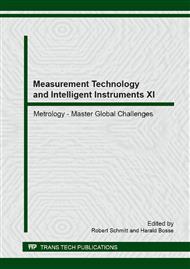p.70
p.81
p.87
p.94
p.101
p.111
p.118
p.125
p.133
A Virtual Instrument for SEM Uncertainty Analysis
Abstract:
To assure the metrological traceability of a measurement, it is required to perform an analysis of the measurement uncertainty specific to the measurement task. An approach to estimate the measurement uncertainty for complex systems is the so-called virtual measuring instrument: The measuring process is simulated taking into account its influencing parameters and a statistical analysis is performed by means of Monte-Carlo calculations. We present the development of such a virtual measuring instrument for scanning electron microscopy (SEM) which allows to estimate the measurement uncertainty in compliance with GUM for dimensional measuring tasks in nano- and microsystems technology. By application of this virtual instrument, model based corrections of systematic errors are made possible and the cognition of the strength of different perturbing influences can lead to recommendations to optimize measurement instruments and methods. The virtual model programmed in MATLAB is called ‘vREM’, it includes all essential components of the measuring chain of an SEM as modules: The electron source, the electron-optical lens-system, the scan-generator, the interaction of the electrons within the object, electron detectors, simple analysis procedures and consideration of external disturbances. By adjusting parameters uncertainty contributions can be assigned to the virtual probe, the virtual specimen and the virtual detector signals.
Info:
Periodical:
Pages:
101-107
Citation:
Online since:
May 2014
Authors:
Price:
Сopyright:
© 2014 Trans Tech Publications Ltd. All Rights Reserved
Share:
Citation:


